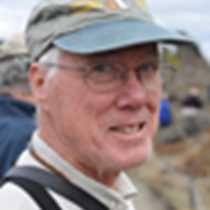Cave Cove, King Haakon Bay, South Georgia Island
The date is May 10, 1916. A small, battered boat pulls into a tiny cove on the south side of South Georgia Island. Its oars almost touch the rock on either side of the cove. Six men aboard the James Caird struggle to reach the shore, as they have struggled for 16 days just to stay alive, to cross 800 miles of turbulent ocean, to find this isolated island in the Southern Ocean, to stand on land once again. They are tired beyond our comprehension; they are wet; their clothing is dirty and tattered, for they have worn the same since leaving “Ocean Camp,” on the ice of the Weddell Sea, over four months earlier. But most immediately, they are thirsty, for their second keg of fresh water was contaminated by ocean water (a fact they discovered only when the first keg was exhausted). And so, upon reaching the shore in what we now call Cave Cove, they throw themselves down face-first into a small rivulet coming down from the tussock-covered slope above and they drink their fill.
Water, food, and sleep, blessed sleep, in that order. For food, they dispatch a juvenile wandering albatross taken from a nest in the tussock. And for sleep they find a small depression in the vertical rock wall of the cove. It is scarcely a cave and it provides scant protection from the conditions of early winter, but it will have to do. The Boss takes the first watch at guarding the James Caird, and he contemplates the next step in his audacious journey to rescue the 22 men who wait on Elephant Island, praying for his success. The other five fall into sleep.
It is February 20, 2009, 93 years after the scene just described. In the intervening years rather few people have visited this site on the exposed side of South Georgia. Even with powered zodiacs it is a challenge to land (and that makes the story of the James Caird all the more remarkable). But the travelers aboard the National Geographic Endeavour did it. For those with a deep interest in the story of Ernest Shackleton and the Endurance expedition, it was a bit of a pilgrimage. Some climbed up the slippery slope to the tussock above, from which came the life-sustaining meal of juvenile albatross. And some lay down on the cold, damp rocks of that so-called cave, trying to imagine six men packed into the small space.
From here, the six men of the James Caird moved farther into King Haakon Bay to a place they called Pegotty Camp, and The Boss, Tom Crean, and The Skipper, Frank Worsley, began their epic trek across the island. But that is another day, another chapter in this most remarkable of tales from the Antarctic.
The date is May 10, 1916. A small, battered boat pulls into a tiny cove on the south side of South Georgia Island. Its oars almost touch the rock on either side of the cove. Six men aboard the James Caird struggle to reach the shore, as they have struggled for 16 days just to stay alive, to cross 800 miles of turbulent ocean, to find this isolated island in the Southern Ocean, to stand on land once again. They are tired beyond our comprehension; they are wet; their clothing is dirty and tattered, for they have worn the same since leaving “Ocean Camp,” on the ice of the Weddell Sea, over four months earlier. But most immediately, they are thirsty, for their second keg of fresh water was contaminated by ocean water (a fact they discovered only when the first keg was exhausted). And so, upon reaching the shore in what we now call Cave Cove, they throw themselves down face-first into a small rivulet coming down from the tussock-covered slope above and they drink their fill.
Water, food, and sleep, blessed sleep, in that order. For food, they dispatch a juvenile wandering albatross taken from a nest in the tussock. And for sleep they find a small depression in the vertical rock wall of the cove. It is scarcely a cave and it provides scant protection from the conditions of early winter, but it will have to do. The Boss takes the first watch at guarding the James Caird, and he contemplates the next step in his audacious journey to rescue the 22 men who wait on Elephant Island, praying for his success. The other five fall into sleep.
It is February 20, 2009, 93 years after the scene just described. In the intervening years rather few people have visited this site on the exposed side of South Georgia. Even with powered zodiacs it is a challenge to land (and that makes the story of the James Caird all the more remarkable). But the travelers aboard the National Geographic Endeavour did it. For those with a deep interest in the story of Ernest Shackleton and the Endurance expedition, it was a bit of a pilgrimage. Some climbed up the slippery slope to the tussock above, from which came the life-sustaining meal of juvenile albatross. And some lay down on the cold, damp rocks of that so-called cave, trying to imagine six men packed into the small space.
From here, the six men of the James Caird moved farther into King Haakon Bay to a place they called Pegotty Camp, and The Boss, Tom Crean, and The Skipper, Frank Worsley, began their epic trek across the island. But that is another day, another chapter in this most remarkable of tales from the Antarctic.




